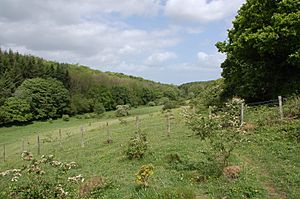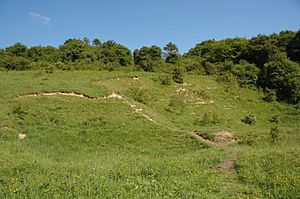Park Gate Down facts for kids
| Site of Special Scientific Interest | |
 |
|
| Area of Search | Kent |
|---|---|
| Interest | Biological |
| Area | 7.0 hectares (17 acres) |
| Notification | 1984 |
| Location map | Magic Map |
Park Gate Down, also known as Parkgate Down, is a special natural area in Kent, England. It covers about 7 hectares, which is roughly the size of 17 football fields! This place is so important for nature that it's called a Site of Special Scientific Interest (SSSI). It's also a Special Area of Conservation (SAC), which means it's protected for its amazing wildlife and habitats across Europe. The Kent Wildlife Trust helps look after this wonderful reserve.
Contents
Exploring Park Gate Down
Park Gate Down is found on the eastern side of a dry valley. This valley is part of the North Downs, a range of hills in Kent. Most of the reserve is covered in chalk grassland. This is a special type of grassy area that grows on chalky soil.
However, some parts on the eastern edges have a mix of woodland and scrub (small trees and bushes). In the south-eastern corner, you can find an old chalk pit that is no longer used. The western and northern parts of the reserve are next to a forest called Elham Park Wood.
Amazing Plants of Park Gate Down
Chalk Grassland Flowers
The main type of plant community at Park Gate Down is called CG4 Brachypodium pinnatum. But you'll also find many other grasses that are not as tall or strong, like sheep's fescue. This reserve is home to a rich variety of plants, especially those that love chalky soil.
Some of the cool plants you can spot include:
- common milkwort
- small scabious
- marjoram
Even rarer plants grow here, such as:
- slender bedstraw
- adder's tongue
- horseshoe vetch
- columbine
Rare Orchids
Park Gate Down is famous for its orchids! Fourteen different types of orchids grow here, including some of the rarest in the UK.
One of the most special is the monkey orchid (Ochis simia). This orchid is nationally rare, and Park Gate Down is one of only three places in the whole UK where it grows! It was brought to this site in the 20th century from another place in Kent and has grown really well, with over 100 plants now.
The reserve also has the nationally rare late spider orchid (Ophrys fuciflora). In the UK, this orchid is only found on the North Downs in East Kent. You can also find the nationally scarce lady orchid (Orchis purpurea) and the musk orchid (Herminium monorchis). In 2007, 72 musk orchids were counted here!
Wildlife at Park Gate Down
Insects and Butterflies
The chalk grassland at Park Gate Down is a perfect home for many insects. Lots of beautiful butterflies live here, including:
- chalkhill blue
- brown argus
- marbled white
Birds of the Woodland
The woodland and scrub areas, both inside and around the reserve, attract many birds. They come here to feed and to build their nests. Some of the birds you might see or hear include:
- nightingale
- European green woodpecker
- great spotted woodpecker
- yellowhammer
- linnet
- whitethroat
- garden warbler
- hawfinch
- sparrowhawk
- hobby
How Park Gate Down is Looked After
The reserve is split into three parts by wire fences. The chalk grassland is kept healthy by animals that graze there every year. From September to December, Highland cattle and Konik ponies eat the grass. This stops tall, strong plants from taking over, which helps the many different types of plants that love chalky soil to grow.
In winter, the scrub (bushes and small trees) is cut back. The woodland is also regularly coppiced. This means cutting trees down to ground level to encourage new shoots to grow. This creates different types of habitats for insects and birds.
You can visit Park Gate Down! There is parking available on the road opposite the entrance on the south side of the reserve. You can walk freely, but it's important to stay on the paths to avoid damaging the delicate plants and habitats.



